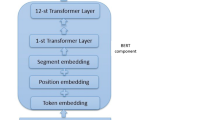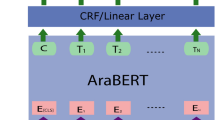Abstract
Aspect sentiment classification (ASC) is a sub-task of aspect-based sentiment analysis (ABSA) that aims at identifying the sentiment polarity toward a specific aspect in a given text or sentence. Most existing research on Arabic ABSA adopted rule-based or machine learning-based methods, with little attention to deep learning techniques. Additionally, the majority of these deep learning-based models relied on attention mechanisms to capture the interaction between the context and aspect words. However, attention-based methods are generally inefficient in extracting the syntactic dependencies between contextual tokens and aspects. Therefore, we introduce a combined model that incorporates an Arabic BERT model with graph convolutional network and local context focus layers to capture syntactic dependencies relevant to a specific aspect while emphasizing the contribution of semantic-related tokens related to this aspect. We also integrate affective commonsense knowledge into the graph networks to capture the sentiment-related dependencies between contextual words and the specific aspect. The experimental results on an Arabic hotel dataset show that the proposed method outperforms the baseline and related work models and achieves a state-of-the-art accuracy score of 92.77% in Arabic ASC. The achieved results show the effectiveness of the proposed model in enhancing the aspect-specific sentiment representations, which can be promising for future research in this field.






Similar content being viewed by others
References
Abas AR, El-Henawy I, Mohamed H, Abdellatif A (2020) Deep learning model for fine-grained aspect-based opinion mining. IEEE Access 8:128845–128855. https://doi.org/10.1109/ACCESS.2020.3008824
Abdelgwad MM, Soliman TH, Taloba AI, Farghaly MF (2021) Arabic aspect based sentiment analysis using bidirectional GRU based models. J King Saud Univ Comput Inf Sci. https://doi.org/10.1016/j.jksuci.2021.08.030
Abdelgwad MM, Soliman THA, Taloba AI (2022) Arabic aspect sentiment polarity classification using BERT. J Big Data 9(1):115. https://doi.org/10.1186/s40537-022-00656-6
Al-Dabet S, Tedmori S, Mohammad A-S (2021) Enhancing Arabic aspect-based sentiment analysis using deep learning models. Comput Speech Lang 69:101224
Alqurashi T (2023) Arabic sentiment analysis for twitter data: a systematic literature review. Eng Technol Appl Sci Res 13(2):10292–10300. https://doi.org/10.48084/etasr.5662
Al-Smadi M, Qawasmeh O, Talafha B, Al-Ayyoub M, Jararweh Y, Benkhelifa E (2016) An enhanced framework for aspect-based sentiment analysis of Hotels’ reviews: Arabic reviews case study. In: 2016 11th international conference for internet technology and secured transactions (ICITST), pp 98–103
Al-Smadi M, Talafha B, Al-Ayyoub M, Jararweh Y (2019) Using long short-term memory deep neural networks for aspect-based sentiment analysis of Arabic reviews. Int J Mach Learn Cybern 10(8):2163–2175
Al-Smadi M, Hammad MM, Al-Zboon SA, Al-Tawalbeh S, Cambria E (2023) Gated recurrent unit with multilingual universal sentence encoder for Arabic aspect-based sentiment analysis. Knowl-Based Syst 261:107540. https://doi.org/10.1016/j.knosys.2021.107540
Antoun W, Baly F, Hajj H (2020) AraBERT: transformer-based model for arabic language understanding. In: Proceedings of the 4th workshop on open-source Arabic corpora and processing tools, with a shared task on offensive language detection
Bensoltane R, Zaki T (2023a) Aspect-based sentiment analysis: an overview in the use of Arabic language. Artif Intell Rev 56(3):2325–2363. https://doi.org/10.1007/s10462-022-10215-3
Bensoltane R, Zaki T (2023b) Combining BERT with TCN-BiGRU for enhancing Arabic aspect category detection. J Intell Fuzzy Syst 44:4123–4136. https://doi.org/10.3233/JIFS-221214
Bisio F, Meda C, Gastaldo P, Zunino R, Cambria E (2017) Concept-level sentiment analysis with SenticNet. In: Cambria E, Das D, Bandyopadhyay S, Feraco A (eds) A practical guide to sentiment analysis. Socio-affective computing, vol 5. Springer, Cham. https://doi.org/10.1007/978-3-319-55394-8_9
Cambria E, Havasi C, Hussain A (2012) Senticnet 2: a semantic and affective resource for opinion mining and sentiment analysis. Twenty-fifth international FLAIRS conference
Cambria E, Olsher D, Rajagopal D (2014) SenticNet 3: a common and common-sense knowledge base for cognition-driven sentiment analysis. Twenty-eighth AAAI conference on artificial intelligence
Cambria E, Poria S, Bajpai R, Schuller B (2016) SenticNet 4: a semantic resource for sentiment analysis based on conceptual primitives. In: Proceedings of COLING 2016, the 26th international conference on computational linguistics, Technical papers
Chen J, Yang T, Huang Z, Wang K, Liu M, Lyu C (2023) Incorporating structured emotion commonsense knowledge and interpersonal relation into context-aware emotion recognition. Appl Intell 53(4):4201–4217
Costola M, Hinz O, Nofer M, Pelizzon L (2023) Machine learning sentiment analysis, COVID-19 news and stock market reactions. Res Int Bus Finance 64:101881
Devlin J, Chang M-W, Lee K, Toutanova K (2019) BERT: pre-training of deep bidirectional transformers for language understanding. In: Proceedings of the 2019 conference of the north American chapter of the association for computational linguistics: human language technologies, vol 1 (Long and Short Papers)
Du Y, Li T, Pathan MS, Teklehaimanot HK, Yang Z (2022) An effective sarcasm detection approach based on sentimental context and individual expression habits. Cognit Comput 1–13
ElSahar H, El-Beltagy SR (2015) Building large arabic multi-domain resources for sentiment analysis
Fadel AS, Abulnaja OA, Saleh ME (2023) Multi-task learning model with data augmentation for arabic aspect-based sentiment analysis. Comput Mater Contin 75(2)
Gu T, Zhao H, He Z, Li M, Ying D (2023) Integrating external knowledge into aspect-based sentiment analysis using graph neural network. Knowl-Based Syst 259:110025. https://doi.org/10.1016/j.knosys.2022.110025
Huang B, Ou Y, Carley KM (2018) Aspect level sentiment classification with attention-over-attention neural networks. In: International conference on social computing, behavioral-cultural modeling and prediction and behavior representation in modeling and simulation
Huang B, Zhang J, Ju J, Guo R, Fujita H, Liu J (2023a) CRF-GCN: an effective syntactic dependency model for aspect-level sentiment analysis. Knowl-Based Syst 260:110125. https://doi.org/10.1016/j.knosys.2022.110125
Huang H, Asemi A, Mustafa MB (2023) Sentiment analysis in E-commerce platforms: a review of current techniques and future directions. IEEE Access
Kastrati Z, Arifaj B, Lubishtani A, Gashi F, Nishliu E (2020) Aspect-based opinion mining of students’ reviews on online courses. In: Proceedings of the 2020 6th international conference on computing and artificial intelligence
Li X, Zhang J, Du Y, Zhu J, Fan Y, Chen X (2023) A novel deep learning-based sentiment analysis method enhanced with Emojis in microblog social networks. Enterp Inf Syst 17(5):2037160
Liang B, Su H, Gui L, Cambria E, Xu R (2022) Aspect-based sentiment analysis via affective knowledge enhanced graph convolutional networks. Knowl-Based Syst 235:107643
Liu H, Wu Y, Li Q, Lu W, Li X, Wei J, Liu X, Feng J (2023) Enhancing aspect-based sentiment analysis using a dual-gated graph convolutional network via contextual affective knowledge. Neurocomputing 553:126526. https://doi.org/10.1016/j.neucom.2023.126526
Ma D, Li S, Zhang X, Wang H (2017) Interactive attention networks for aspect-level sentiment classification. IJCAI
Madan M, Rani A, Bhateja N (2023) Applications of named entity recognition using graph convolution network. SN Comput Sci 4(3):266. https://doi.org/10.1007/s42979-023-01739-8
Mikolov T, Chen K, Corrado G, Dean J (2013) Efficient estimation of word representations in vector space. Preprint http://arxiv.org/abs/1301.3781
Omar A, Abd El-Hafeez T (2023) Quantum computing and machine learning for Arabic language sentiment classification in social media. Sci Rep 13(1):17305. https://doi.org/10.1038/s41598-023-44113-7
Pennington J, Socher R, Manning CD (2014) Glove: global vectors for word representation. In: Proceedings of the 2014 conference on empirical methods in natural language processing (EMNLP)
Pontiki M, Galanis D, Papageorgiou H, Androutsopoulos I, Manandhar S, Al-Smadi M, Al-Ayyoub M, Zhao Y, Qin B, De Clercq O (2016). Semeval-2016 task 5: aspect based sentiment analysis. International workshop on semantic evaluation
Rodríguez-Ibánez M, Casánez-Ventura A, Castejón-Mateos F, Cuenca-Jiménez P-M (2023) A review on sentiment analysis from social media platforms. Expert Syst Appl 119862
Ruder S, Ghaffari P, Breslin JG (2016) INSIGHT-1 at SemEval-2016 task 5: deep learning for multilingual aspect-based sentiment analysis. Proc SemEval 330–336
Soliman AB, Eissa K, El-Beltagy SR (2017) AraVec: a set of Arabic word embedding models for use in Arabic NLP. Procedia Comput Sci 117:256–265. https://doi.org/10.1016/j.procs.2017.10.117
Wang Y, Huang M, Zhu X, Zhao L (2016) Attention-based LSTM for aspect-level sentiment classification. In: Proceedings of the 2016 conference on empirical methods in natural language processing
Wu M (2023) Commonsense knowledge powered heterogeneous graph attention networks for semi-supervised short text classification. Expert Syst Appl 120800
Xu C, Luo X, Wang D (2022) MCPR: a Chinese product review dataset for multimodal aspect-based sentiment analysis. Cognitive Computing—ICCC 2022, Cham
Yang Z, Dai Z, Yang Y, Carbonell J, Salakhutdinov RR, Le QV (2019) XLNet: generalized autoregressive pretraining for language understanding. Adv Neural Inf Process Syst 32:5753–5763
Yang H, Zeng B, Yang J, Song Y, Xu R (2021) A multi-task learning model for Chinese-oriented aspect polarity classification and aspect term extraction. Neurocomputing 419:344–356
Yang G, Xu Y, Tu L (2023) An intelligent box office predictor based on aspect-level sentiment analysis of movie review. Wirel Netw 29(7):3039–3049
Yusuf AA, Chong F, Xianling M (2022) Evaluation of graph convolutional networks performance for visual question answering on reasoning datasets. Multimed Tools Appl 81(28):40361–40370
Zeng B, Yang H, Xu R, Zhou W, Han X (2019) LCF: a local context focus mechanism for aspect-based sentiment classification. Appl Sci 9(16):3389
Zhang M, Qian T (2020) Convolution over hierarchical syntactic and lexical graphs for aspect level sentiment analysis. In: Proceedings of the 2020 conference on empirical methods in natural language processing (EMNLP)
Zhang C, Li Q, Song D (2019) Aspect-based sentiment classification with aspect-specific graph convolutional networks. In: Proceedings of the 2019 conference on empirical methods in natural language processing and the 9th international joint conference on natural language processing (EMNLP-IJCNLP)
Zhao A, Yu Y (2021) Knowledge-enabled BERT for aspect-based sentiment analysis. Knowl-Based Syst 107220
Zhao P, Hou L, Wu O (2020) Modeling sentiment dependencies with graph convolutional networks for aspect-level sentiment classification. Knowl-Based Syst 193:105443
Zhou J, Huang JX, Hu QV, He L (2020) SK-GCN: modeling syntax and knowledge via graph convolutional network for aspect-level sentiment classification. Knowl-Based Syst 205:106292
Zhao H, Xie J, Wang H (2022a) Graph convolutional network based on multi-head pooling for short text classification. IEEE Access 10:11947–11956
Zhao Z, Tang M, Tang W, Wang C, Chen X (2022b) Graph convolutional network with multiple weight mechanisms for aspect-based sentiment analysis. Neurocomputing 500:124–134. https://doi.org/10.1016/j.neucom.2022.05.045
Zhao Y, Zhang L, Zeng C, Lu W, Chen Y, Fan T (2023) Construction of an aspect-level sentiment analysis model for online medical reviews. Inf Process Manage 60(6):103513
Funding
The authors did not receive support from any organization for the submitted work.
Author information
Authors and Affiliations
Contributions
Rajae Bensoltane: Conceptualization, Methodology, Software, Validation, Investigation, Writing - original draft, Writing - review & editing. Taher Zaki: Conceptualization, Methodology, Investigation, Writing - review & editing, Supervision.
Corresponding author
Ethics declarations
Competing interests
The authors declare no competing interests.
Additional information
Publisher's Note
Springer Nature remains neutral with regard to jurisdictional claims in published maps and institutional affiliations.
Rights and permissions
Springer Nature or its licensor (e.g. a society or other partner) holds exclusive rights to this article under a publishing agreement with the author(s) or other rightsholder(s); author self-archiving of the accepted manuscript version of this article is solely governed by the terms of such publishing agreement and applicable law.
About this article
Cite this article
Bensoltane, R., Zaki, T. Knowledge-enhanced graph convolutional networks for Arabic aspect sentiment classification. Soc. Netw. Anal. Min. 14, 6 (2024). https://doi.org/10.1007/s13278-023-01166-w
Received:
Revised:
Accepted:
Published:
DOI: https://doi.org/10.1007/s13278-023-01166-w




